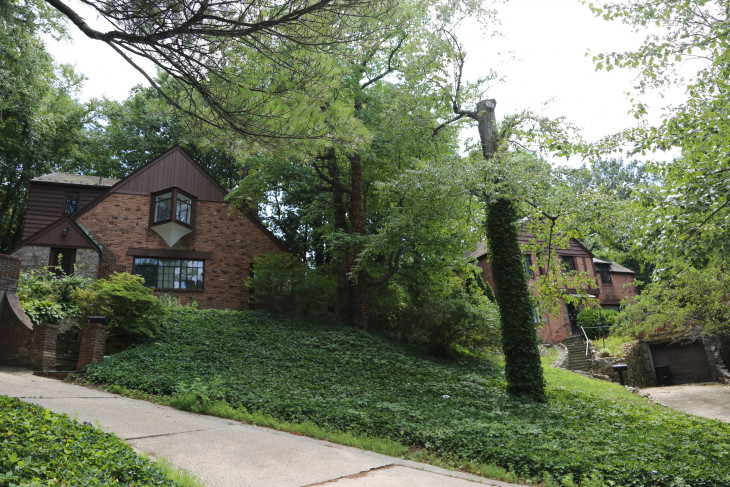Sinclair Martin Drive Houses
Sinclair Martin Drive, Roslyn

History of property: "Roslyn Court," now Sinclair Martin Drive, was developed in 1938, and envisioned at that time as a much larger development of 80 to 85 homes that would have engulfed the hill to the south. The larger development is identified as "Roslyn Hills" in the Roslyn Village Board of Trustees minutes. The houses were to range in price from $9,000 to $20,000.
Four houses were apparently constructed in 1938, and the remaining houses on the street constructed between 1938 and 1940. In an extended debate about conditions, the street was eventually dedicated to the Village. In 1940 a Mr. Schillinger (representing the developer?) requested permission to erect a plant to "screen and wash sand and gravel, being approximately three million yards over a period of five years, which would result in the complete removal of the high hill, believed to be the only solution to complete the development of Roslyn Hills..." Apparently, the request was not granted; Roslyn Court was the only street of the projected development ever completed.
The street name was changed shortly after World War II in memory of a Roslyn soldier who grew up across Northern Boulevard and was killed in World War II.
The possibility exists that the group of buildings was designed by Roslyn architect Henry Johanson, the architect of the Roslyn Rescue Hook & Ladder Company, and likely the designer of the Lincoln Building as well as a small Queen Anne Revival style office building on Bryant Avenue as well. The Tudor Revival style was very popular at the time of Roslyn Court's construction, and any architect or builder would have been likely to build a coherent group of houses in the style. The style appears in a larger scale in nearby Roslyn Harbor, nicknamed "stockbroker's Tudor," and on a smaller scale throughout East Hills and Flower Hill. The group is unique, however, within the incorporated village of Roslyn.
SIGNIFICANCE Designation of Sinclair Martin Drive as a local Historic District was prepared by Dr. Roger Gerry during 1993, submitted to the Historic District Board January 1994 with subsequent approval. Statement of significance should refer to the importance of the site in terms of American history, architecture, archaeology, engineering or culture; and relate specifically to the property's integrity of location, design, setting, materials and workmanship. The residences located on Sinclair Martin Drive are a coherent group, designed to complement one another and their site, more than to stand alone as individual buildings In fact, they were conceived as part of a much larger group which would have necessitated large-scale alteration to their hillside site. The more modest development in fact benefits from its steep site and the architect/ designer took the opportunity to sculpt vehicle and pedestrian approaches to the houses in harmony with the contours of the hillside. The group is first, therefore, well designed and executed.
Although the expanding development of Long Island after the depression is visible in a number of communities in the Roslyn area, the incorporated village was relatively untouched by subdivision and new construction until after WW II. Understanding the Roslyn Court was never fully accomplished because of site development difficulties offers an explanation for this lack of development of the steep slopes of the east and west areas of the village prohibited cost-effective development on a large scale.
Sinclair Martin Drive becomes, then the sole example of this period of development for the village, and should be preserved for its uniqueness. Finally, the ten original houses retain a great deal of their original detailing and design, and so display a high level of integrity. The minor changes that have been made are reversible and not so obtrusive as to prevent the buildings' being understood as a clear statement of their period and style.
Designation of Sinclair Martin Drive as a local Historic District was prepared by Dr. Roger Gerry during 1993, submitted to the Historic District Board January 1994 and subsequently approved.
2 Comments
Per the January 1936 edition of "Pencil Point", Henry Johanson was indeed the architect of the Lincoln Building. https://usmodernist.org/PA/PP-1936-01.pdf
Henry W. Johanson also designed several homes within Flower Hill, as well as Flower Hill Village Hall. Not only that but he also served as our Building Inspector for several years!